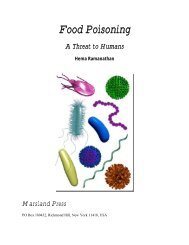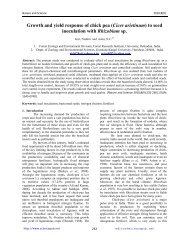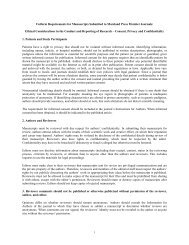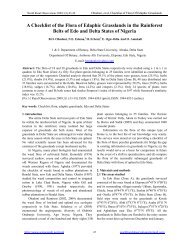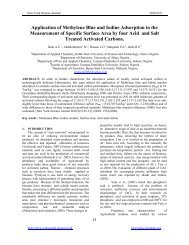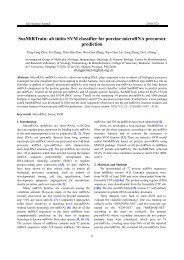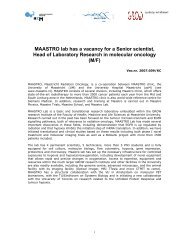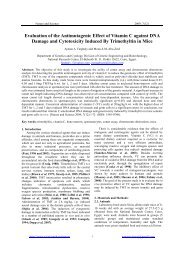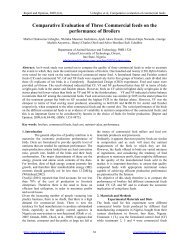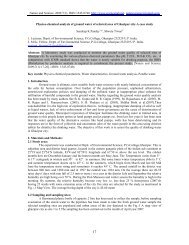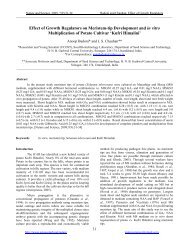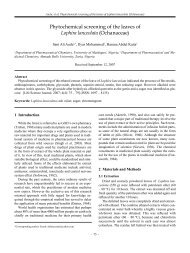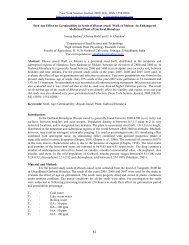Ecological, Social and Commercial Role of Lichens in India with ...
Ecological, Social and Commercial Role of Lichens in India with ...
Ecological, Social and Commercial Role of Lichens in India with ...
Create successful ePaper yourself
Turn your PDF publications into a flip-book with our unique Google optimized e-Paper software.
Acdemia Arena 2010, Supplement 0201<br />
http://www.sciencepub.net<br />
93 Stereocaulon pomiferum Duvign. Stereocaulaceae Foliose On rock<br />
94 Sticta nyl<strong>and</strong>erianaZahlbr. Stictaceae Foliose On bark<br />
95 Sulcaria sulcata (Lev) Bystr. Ex Brodo & D.<br />
Hawkow<br />
Alectoriaceae Foliose On bark<br />
96 Umbilicaria badia Frey Umbilicariaceae Foliose On rock<br />
97 Umbilicaria <strong>in</strong>dica Frey Umbilicariaceae Foliose On rock<br />
98 Umbilicaria virg<strong>in</strong>is Schaerer Umbilicariaceae Foliose On rock<br />
99 Usnea aciculiferaVa<strong>in</strong>io Usneaceae Fruticose On bark<br />
100 Usnea eumitrioides Mot. Usneaceae Fruticose On bark<br />
101 Usnea <strong>in</strong>dica Mot. Usneaceae Fruticose On rock<br />
102 Usnea longissima Ach. Usneaceae Fruticose On bark<br />
103 Usnea orientalis Mot. Usneaceae Fruticose On bark<br />
104 Usnea pect<strong>in</strong>ata (Taylor) Usneaceae Fruticose On bark<br />
105 Usnea subfloridana (Stirton) Usneaceae Fruticose On bark<br />
106 Verrucaria acrotella Ach. Verrucariaceae Crustose On rock<br />
DISCUSSION<br />
The most common lichen species grow<strong>in</strong>g on different phorophytes belongs to the genera<br />
Chrysothrix, Parmelioid, Usnioid <strong>and</strong> Graphidiaceous lichens while Acarospora, Aspicilia,<br />
Umblicaria, Dermatocarpon, Porpidia, Buellia <strong>and</strong> Caloplaca mostly prefers to grow on rocks.<br />
Species <strong>of</strong> lichen genera Peltigera, Lobaria <strong>and</strong> Sticta prefers soil for their growth. The lichen flora<br />
<strong>in</strong> the study area exhibits greatest abundance <strong>in</strong> variety <strong>and</strong> luxuriance <strong>of</strong> growth. The lichens <strong>in</strong> the<br />
study area seem to prefer the bark <strong>of</strong> trees or rock as their substratum. <strong>Lichens</strong> also occur on soil,<br />
decay<strong>in</strong>g wood, mosses <strong>and</strong> humus. The corticolous lichens are greatly <strong>in</strong>fluenced by the physical<br />
characters <strong>of</strong> the bark. Corticolous lichens may be epiphloedal or endophoedal based on their<br />
growth above or <strong>with</strong><strong>in</strong> the substratum. In epiphloedal lichens or the lichen tissue (especially the<br />
algal layer) develops above the outermost corky layer <strong>of</strong> bark, although few layers <strong>of</strong> cork are<br />
<strong>in</strong>corporated <strong>in</strong>to the lower portion <strong>of</strong> the thallus. In endophloedal lichens the thallus crust lies<br />
entirely below the cork <strong>of</strong> periderm. Section <strong>of</strong> endophloedal crustose lichens together <strong>with</strong> their<br />
53




